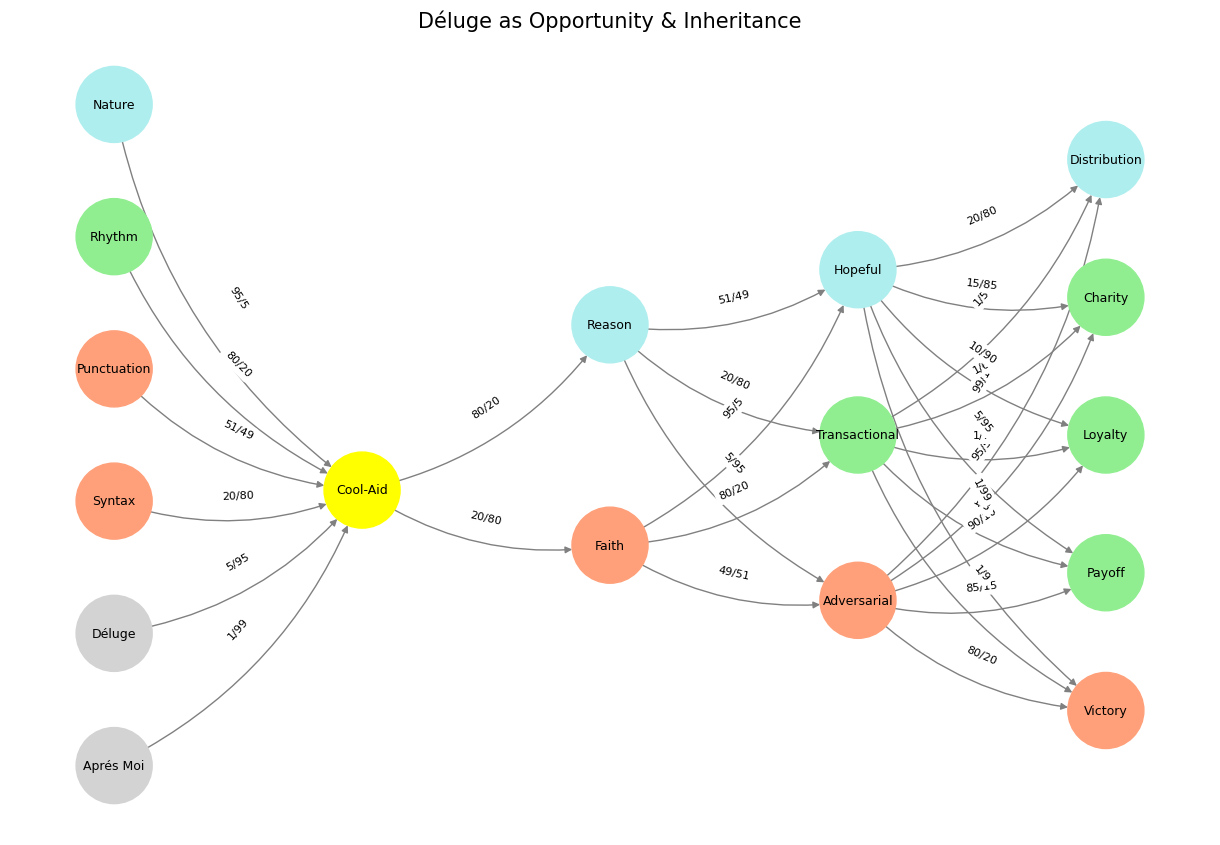Dancing in Chains#
The Nature of Opportunity: Discovery, Inheritance, and the Role of Loss
Opportunities exist at the crossroads of fate and intention. Some are discovered through effort and exploration, while others are inherited, shaped by the past actions of predecessors. Yet, no opportunity remains static. It must be tested through loss, trial, and error before it can be stabilized. This tension between discovery and inheritance, and the necessity of struggle in securing opportunity, forms the core of human progress, shaping individuals, societies, and entire civilizations.
To discover an opportunity is to venture into the unknown, to recognize an inefficiency, a gap, or an unrealized potential. Scientific breakthroughs, artistic revolutions, and entrepreneurial success all stem from individuals perceiving something others have overlooked. Discovery requires perception, curiosity, and, above all, the willingness to take a risk. The explorer, the scientist, and the visionary artist do not inherit their opportunities; they create them by pushing against the boundaries of what is already known. Yet, the very nature of discovery suggests instability—what is found must be tested, refined, and often reshaped through failure before it becomes a foundation upon which others can build.
The foundational grammar!
– Yours Truly
By contrast, inheritance offers a different path—one shaped by legacy rather than novelty. Those who inherit opportunities stand on the shoulders of their predecessors, benefiting from structures, institutions, and wealth that were established before them. Inherited opportunities can be familial, cultural, or national; they take the form of wealth, education, or even reputation. But inheritance alone is not security. Without adaptation and understanding, an inherited opportunity is little more than an untested relic, vulnerable to obsolescence. Many civilizations have risen and fallen on the assumption that past success guarantees future prosperity, failing to recognize that even inheritance must be renewed through trial and engagement.
Stabilization, however, is never immediate. Whether discovered or inherited, an opportunity must pass through fire—through loss, failure, and iteration. Those who believe in effortless stability deceive themselves; nothing worth keeping has been gained without a struggle. Failure is a crucible that burns away what is weak, leaving behind only what is resilient. The scientific method, for example, is built upon iteration—hypotheses tested, refuted, and refined until they produce a truth that can withstand scrutiny. Even personal growth follows this pattern; no one arrives at wisdom without first enduring the pain of mistakes. Loss, then, is not the enemy of opportunity but its proving ground.
The modern world provides ample evidence of this dynamic. Those who inherit wealth but fail to understand its origins often lose it. Those who discover new frontiers but refuse to adapt to changing realities see their empires crumble. The entrepreneurs who fail a dozen times before building something lasting are living proof that success is not found in the absence of failure but in the refusal to be broken by it. Even nations and ideologies follow this arc—empires that fail to reassess their foundations collapse, while those that learn from crisis emerge stronger.
In the end, opportunity is neither given nor taken; it is shaped. Discovery and inheritance are only beginnings, mere openings in the vast, uncertain terrain of life. The real work lies in transformation—trial, error, and the loss of illusions. What remains after the struggle is the opportunity that endures, no longer an accident of fate but a creation of will and resilience.
Show code cell source
import numpy as np
import matplotlib.pyplot as plt
import networkx as nx
# Define the neural network layers
def define_layers():
return {
'Suis': ['Aprés Moi', 'Déluge', 'Syntax', 'Punctuation', "Rhythm", 'Nature'], # Static
'Voir': ['Cool-Aid'],
'Choisis': ['Faith', 'Reason'],
'Deviens': ['Adversarial', 'Transactional', 'Hopeful'],
"M'èléve": ['Victory', 'Payoff', 'Loyalty', 'Charity', 'Distribution']
}
# Assign colors to nodes
def assign_colors():
color_map = {
'yellow': ['Cool-Aid'],
'paleturquoise': ['Nature', 'Reason', 'Hopeful', 'Distribution'],
'lightgreen': ["Rhythm", 'Transactional', 'Payoff', 'Charity', 'Loyalty'],
'lightsalmon': ['Syntax', 'Punctuation', 'Faith', 'Adversarial', 'Victory'],
}
return {node: color for color, nodes in color_map.items() for node in nodes}
# Define edge weights (hardcoded for editing)
def define_edges():
return {
('Aprés Moi', 'Cool-Aid'): '1/99',
('Déluge', 'Cool-Aid'): '5/95',
('Syntax', 'Cool-Aid'): '20/80',
('Punctuation', 'Cool-Aid'): '51/49',
("Rhythm", 'Cool-Aid'): '80/20',
('Nature', 'Cool-Aid'): '95/5',
('Cool-Aid', 'Faith'): '20/80',
('Cool-Aid', 'Reason'): '80/20',
('Faith', 'Adversarial'): '49/51',
('Faith', 'Transactional'): '80/20',
('Faith', 'Hopeful'): '95/5',
('Reason', 'Adversarial'): '5/95',
('Reason', 'Transactional'): '20/80',
('Reason', 'Hopeful'): '51/49',
('Adversarial', 'Victory'): '80/20',
('Adversarial', 'Payoff'): '85/15',
('Adversarial', 'Loyalty'): '90/10',
('Adversarial', 'Charity'): '95/5',
('Adversarial', 'Distribution'): '99/1',
('Transactional', 'Victory'): '1/9',
('Transactional', 'Payoff'): '1/8',
('Transactional', 'Loyalty'): '1/7',
('Transactional', 'Charity'): '1/6',
('Transactional', 'Distribution'): '1/5',
('Hopeful', 'Victory'): '1/99',
('Hopeful', 'Payoff'): '5/95',
('Hopeful', 'Loyalty'): '10/90',
('Hopeful', 'Charity'): '15/85',
('Hopeful', 'Distribution'): '20/80'
}
# Calculate positions for nodes
def calculate_positions(layer, x_offset):
y_positions = np.linspace(-len(layer) / 2, len(layer) / 2, len(layer))
return [(x_offset, y) for y in y_positions]
# Create and visualize the neural network graph
def visualize_nn():
layers = define_layers()
colors = assign_colors()
edges = define_edges()
G = nx.DiGraph()
pos = {}
node_colors = []
# Add nodes and assign positions
for i, (layer_name, nodes) in enumerate(layers.items()):
positions = calculate_positions(nodes, x_offset=i * 2)
for node, position in zip(nodes, positions):
G.add_node(node, layer=layer_name)
pos[node] = position
node_colors.append(colors.get(node, 'lightgray'))
# Add edges with weights
for (source, target), weight in edges.items():
if source in G.nodes and target in G.nodes:
G.add_edge(source, target, weight=weight)
# Draw the graph
plt.figure(figsize=(12, 8))
edges_labels = {(u, v): d["weight"] for u, v, d in G.edges(data=True)}
nx.draw(
G, pos, with_labels=True, node_color=node_colors, edge_color='gray',
node_size=3000, font_size=9, connectionstyle="arc3,rad=0.2"
)
nx.draw_networkx_edge_labels(G, pos, edge_labels=edges_labels, font_size=8)
plt.title("Déluge as Opportunity & Inheritance", fontsize=15)
plt.show()
# Run the visualization
visualize_nn()


Fig. 28 G1-G3: Ganglia & N1-N5 Nuclei. These are cranial nerve, dorsal-root (G1 & G2); basal ganglia, thalamus, hypothalamus (N1, N2, N3); and brain stem and cerebelum (N4 & N5).#

